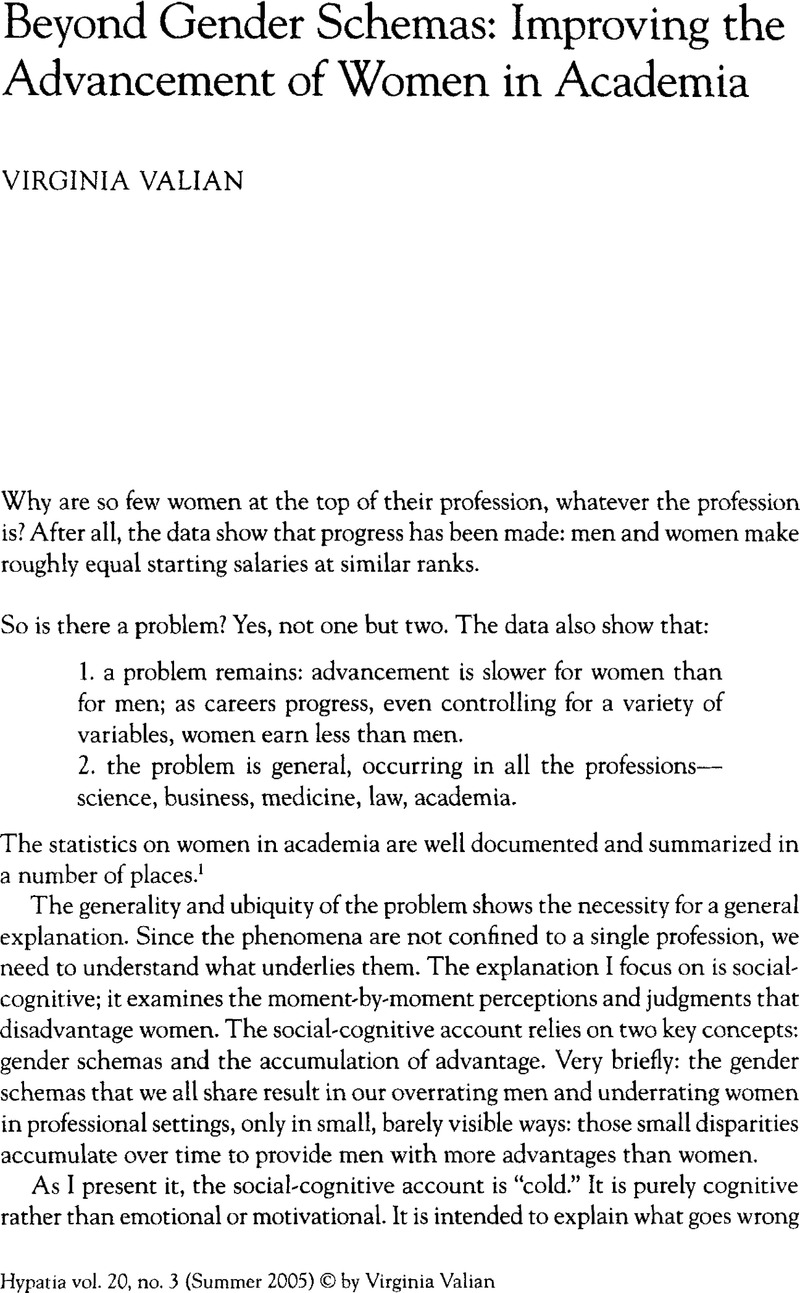Crossref Citations
This article has been cited by the following publications. This list is generated based on data provided by Crossref.
Cohoon, J. McGrath
2007.
Gendered experiences of computing graduate programs.
ACM SIGCSE Bulletin,
Vol. 39,
Issue. 1,
p.
546.
Anastas, Jeane W.
2007.
Theorizing (In)Equity for Women in Social Work.
Affilia,
Vol. 22,
Issue. 3,
p.
235.
Cohoon, J. McGrath
2007.
Gendered experiences of computing graduate programs.
p.
546.
WALLACE, KATHLEEN
2007.
MORAL REFORM, MORAL DISAGREEMENT, AND ABORTION.
Metaphilosophy,
Vol. 38,
Issue. 4,
p.
380.
Damarin, Suzanne
2008.
Toward Thinking Feminism and Mathematics Together.
Signs: Journal of Women in Culture and Society,
Vol. 34,
Issue. 1,
p.
101.
Xu, Yonghong Jade
2008.
Gender Disparity in STEM Disciplines: A Study of Faculty Attrition and Turnover Intentions.
Research in Higher Education,
Vol. 49,
Issue. 7,
p.
607.
Rogers, Dorothy
2009.
The Other Philosophy Club: America's First Academic Women Philosophers.
Hypatia,
Vol. 24,
Issue. 2,
p.
164.
Taylor, Kay Ann
and
Robinson, Daniel C.
2009.
Unleashing the Potential: Women's Development and Ways of Knowing as a Perspective for Veterinary Medical Education.
Journal of Veterinary Medical Education,
Vol. 36,
Issue. 1,
p.
135.
Feeney, Mary K.
and
Bernal, Margarita
2010.
Women in STEM networks: who seeks advice and support from women scientists?.
Scientometrics,
Vol. 85,
Issue. 3,
p.
767.
Szmer, John J.
Sarver, Tammy A.
and
Kaheny, Erin B.
2010.
Have We Come a Long Way, Baby? The Influence of Attorney Gender on Supreme Court Decision Making.
Politics & Gender,
Vol. 6,
Issue. 1,
p.
1.
Elg, Ulf
and
Jonnergård, Karin
2010.
Included or excluded? The dual influences of the organisational field and organisational practices on new female academics.
Gender and Education,
Vol. 22,
Issue. 2,
p.
209.
Xu, Yonghong Jade
and
Martin, Cynthia L.
2011.
Gender Differences in STEM Disciplines: From the Aspects of Informal Professional Networking and Faculty Career Development.
Gender Issues,
Vol. 28,
Issue. 3,
p.
134.
Gaze, Beth
and
Stevens, Carolyn
2011.
Running risks of gender inequity: knowledge transfer policy in Australian higher education.
Journal of Education Policy,
Vol. 26,
Issue. 5,
p.
621.
Poltera, Jacqui
2011.
Women and the Ethos of Philosophy: Shedding Light on Mentoring and Competition.
Hypatia,
Vol. 26,
Issue. 2,
p.
419.
Kaheny, Erin B.
Szmer, John J.
and
Sarver, Tammy A.
2011.
Women Lawyers before the Supreme Court of Canada.
Canadian Journal of Political Science,
Vol. 44,
Issue. 1,
p.
83.
Grasswick, Heidi E.
2011.
Feminist Epistemology and Philosophy of Science.
p.
241.
Summerfield, Gale
Dong, Xiao-yuan
Aslanbeigui, Nahid
and
Hu, Jie
2011.
Wage Differentials, Occupational Segregation, and Gendered Creativity Perceptions in the Chinese Science and Technology Sector: Beijing and Wuhan.
Eastern Economic Journal,
Vol. 37,
Issue. 2,
p.
178.
O’Meara, KerryAnn
2011.
Higher Education: Handbook of Theory and Research.
Vol. 26,
Issue. ,
p.
161.
Brownstein, Michael
and
Madva, Alex
2012.
Ethical Automaticity.
Philosophy of the Social Sciences,
Vol. 42,
Issue. 1,
p.
68.
Saul, Jennifer
2012.
Ranking Exercises in Philosophy and Implicit Bias.
Journal of Social Philosophy,
Vol. 43,
Issue. 3,
p.
256.



